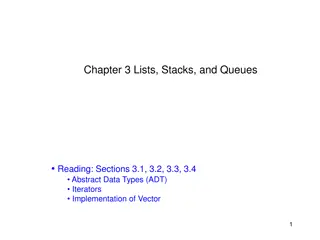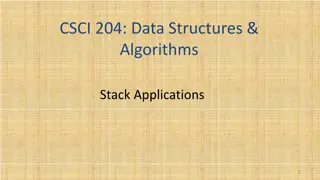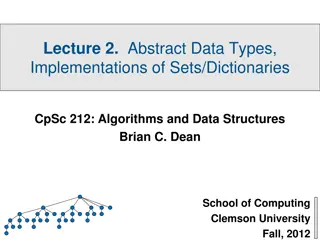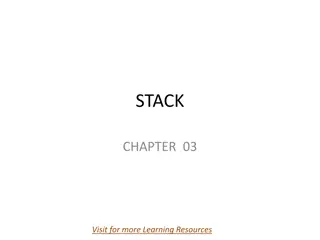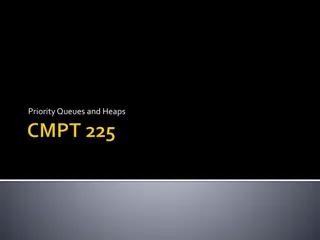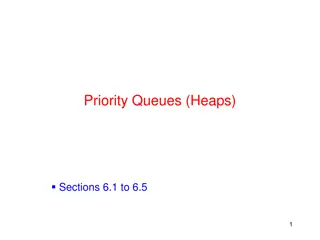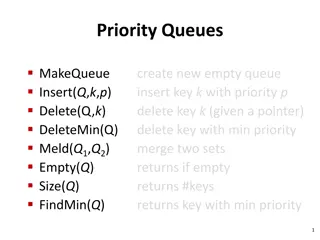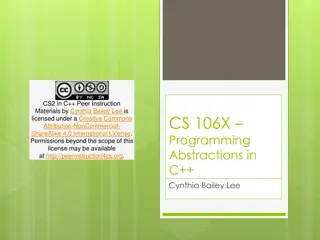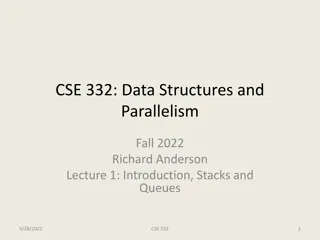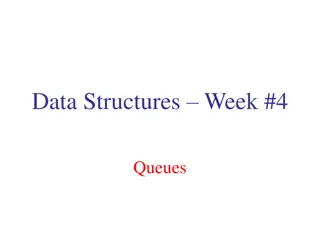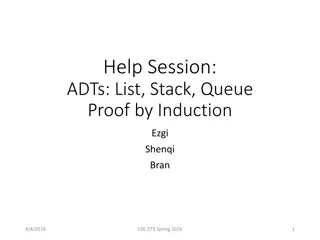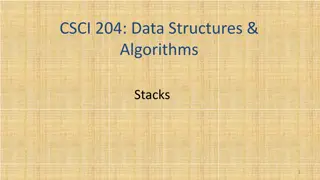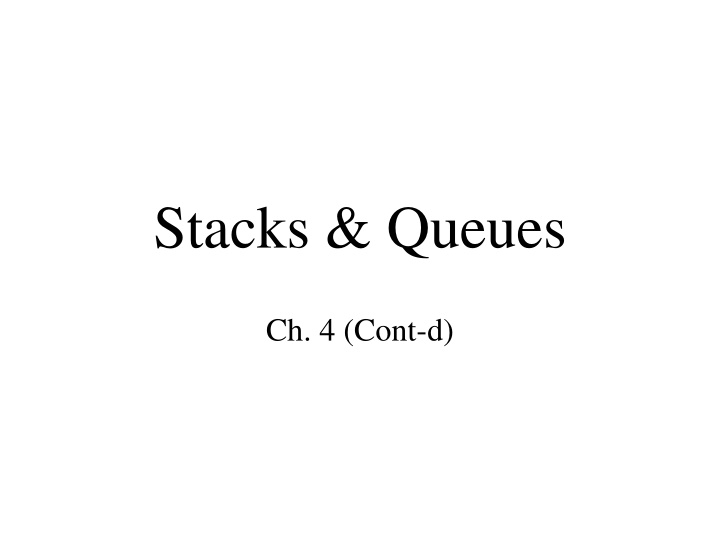
Understanding Stacks and Queues in Data Structures
Explore the concepts of stacks and queues in data structures through detailed explanations of their implementation, operations, and efficiency. Learn about array-based stack structures and the cost analysis of push and pop operations, among other key topics.
Download Presentation

Please find below an Image/Link to download the presentation.
The content on the website is provided AS IS for your information and personal use only. It may not be sold, licensed, or shared on other websites without obtaining consent from the author. If you encounter any issues during the download, it is possible that the publisher has removed the file from their server.
You are allowed to download the files provided on this website for personal or commercial use, subject to the condition that they are used lawfully. All files are the property of their respective owners.
The content on the website is provided AS IS for your information and personal use only. It may not be sold, licensed, or shared on other websites without obtaining consent from the author.
E N D
Presentation Transcript
Stacks & Queues Ch. 4 (Cont-d)
Project related assignment Data Structures - List Define and document project objectives, requirements, and project delivery plan. Due November 10. 2009 Define and document design by November 17, 2009. Additional assignments may also be provided.
Top of the stack STACKS of ITEMS
Stacks Stack: list of homogenous elements Addition and deletion occurs only at one end, called the top of the stack Data Structures - List Last in first out (LIFO) data structure LIFO: Last In, First Out. Insert: PUSH Remove: POP The accessible element is called TOP.
Stack ADT // Stack abstract class template <class Elem> class Stack { public: // Reinitialize the stack virtual void clear() = 0; // Push an element onto the top of the stack. virtual bool push(const Elem&) = 0; // Remove the element at the top of the stack. virtual bool pop(Elem&) = 0; // Get a copy of the top element in the stack virtual bool topValue(Elem&) const = 0; // Return the number of elements in the stack. virtual int length() const = 0; }; Data Structures - List There are many ways to implement stacks. We will consider Arrays and Links
Stacks as Arrays Stack elements are stored in an array Data Structures - List The top of the stack is the index of the last element added to the stack To keep track of the top position use a variable called top Can dynamically allocate variable size elements in an array
Array-Based Stack // Array-based stack implementation private: int size; // Maximum size of stack int top; // Index for top element Elem *listArray; // Array holding elements Data Structures - List Issues: Which end is the top? What is the cost of the operations?
Push/Pop Cost with Array Stack Data Structures - List If top is 0 , then all PUSH and POP would be order (n) why? Inefficient If top is current size of array , then PUSH and POP are order (1) Efficient What is top when stack is empty? To push x: put x into topmost slot, increment top To pop: Decrement top, get the topmost element See detailed code
AStack // Array-based stack implementation template <class Elem> class AStack: public Stack<Elem> { private: int size; // Maximum size of stack int top; // Index for top element Elem *listArray; // Array holding stack elements public: AStack(int sz =DefaultListSize) // Constructor { size = sz; top = 0; listArray = new Elem[sz]; } ~AStack() { delete [] listArray; } // Destructor void clear() { top = 0; } bool push(const Elem& item) { if (top == size) return false; // Stack is full else { listArray[top++] = item; return true; } } bool pop(Elem& it) { // Pop top element if (top == 0) return false; else { it = listArray[--top]; return true; } } bool topValue(Elem& it) const { // Return top element if (top == 0) return false; else { it = listArray[top-1]; return true; } } int length() const { return top; } }; Last element in Array Data Structures - List Destructor clears memory Clear() just sets top
Linked Stack A linked list can be used to implement the stack. The top of the stack is the head of the list To push x: insert a node at the head To pop: remove a node from the head Data Structures - List
Linked Stack // Linked stack implementation private: Link<Elem>* top; // Pointer to first elem int size; // Count number of elems Data Structures - List What is the cost of the operations? PUSH and POP are order (1) Efficient How do space requirements compare to the array-based stack implementation? Depends on static vs dynamic choice/need. See Code Details
Lstack (1/2) // Link list-based stack implementation template <class Elem> class LStack: public Stack<Elem> { private: Link<Elem>* top; // Pointer to first element int size; // Count number of elements public: LStack(int sz =DefaultListSize) { top = NULL; size = 0; } ~LStack() { clear(); } // Destructor void clear() { while (top != NULL) { // Delete link nodes Link<Elem>* temp = top; top = top->next; size = 0; delete temp; } } Data Structures - List Destructor and clear(): Both clear memory
Lstack (2/2) bool push(const Elem& item) { top = new Link<Elem>(item, top); //dynamic allocation needed size++; return true; } bool pop(Elem& it) { if (size == 0) return false; it = top->element; Link<Elem>* ltemp = top->next; delete top; top = ltemp; size--; return true; } bool topValue(Elem& it) const { if (size == 0) return false; it = top->element; return true; } int length() const { return size; } }; // not required with AStack Data Structures - List //Need to delete top, not needed with AStack
Queues FIFO: First in, First Out Similar to standing in line at the bank / intersection (In Beirut ) Data Structures - List Restricted form of list: Insert at one end (rear), remove from the other (front). Notations: Insert: Enqueue Delete: Dequeue First element: Front Last element: Rear
Queue ADT // Abstract queue class template <class Elem> class Queue { public: // Reinitialize the queue. The user is responsible for // reclaiming the storage used by the queue elements. virtual void clear() = 0; // Place an element at the rear of the queue. Return // true if successful, false if not (if queue is full). virtual bool enqueue(const Elem&) = 0; // Remove the element at the front of the queue. Return // true if successful, false if queue is empty. // The element removed is returned in the first parameter. virtual bool dequeue(Elem&) = 0; // Remove Elem from front // Return in a copy of the front element. // Return true if successful, false if queue is empty. virtual bool frontValue(Elem&) const = 0; // Return the number of elements in the queue. virtual int length() const = 0; }; Data Structures - List
Serial Queue Implementation Data Structures - List Fixing front at 0 is costly why? Dequeue 20, 5 Enqueue 3,30, 4 Allowing front and rear to drift causes a problem why?
Circular Queue Implementation(1) Drift operations To insert: increment rear, then assign To remove: get value, then increment front To increment: rear=rear+1 Solution to drift: Circular Array In a circular array: rear=(rear+1)%size Data Structures - List
Circular Queue Implementation (2) Dequeue 20, 5 Data Structures - List Enqueue 3,30, 4 We solved the problem of efficiency but new problem: how do we know when list is empty? Full?
Queue Implementation(3) Given a fixed position for the front element (and its pointer), there are n+1 possible states for the queue (0 through n elements in the queue for an array of size n), but only n possible positions for rear. Example States of the queue: Initially rear = 0, front = 1 rear=front: one element in queue rear+1=front: empty queue (initial state) rear+1=front: full queue (after queue gets full) Solution: queue size is n, array size is n+1 Or keep track of size Data Structures - List
rear rear x x x x x x x x x x EMPTY STATE FULL STATE
Queue Implementation(4) Data Structures - List Solution to deciding empty/full: rear+1=front: empty queue rear+2=front: full queue One element is unused: Allow to distinguish between empty and full queue See detailed Code
Aqueue Implementation (1/2) // Array-based queue implementation template <class Elem> class AQueue: public Queue<Elem> { private: int size; // Maximum size of queue int front; // Index of front element int rear; // Index of rear element Elem *listArray; // Array holding queue elements public: AQueue(int sz =DefaultListSize) { // Constructor // Make list array one position larger for empty slot size = sz+1; rear = 0; front = 1; listArray = new Elem[size]; } ~AQueue() { delete [] listArray; } // Destructor void clear() { front = 1; rear = 0; } Data Structures - List Initialize array with one extra slot
Aqueue Implementation (2/2) bool enqueue(const Elem& it) { if (((rear+2) % size) == front) return false; // Full rear = (rear+1) % size; // Circular increment listArray[rear] = it; return true; } bool dequeue(Elem& it) { if (length() == 0) return false; // Empty it = listArray[front]; front = (front+1) % size; // Circular increment return true; } bool frontValue(Elem& it) const { if (length() == 0) return false; // Empty it = listArray[front]; return true; } virtual int length() const { return ((rear+size) - front + 1) % size; } }; Check FULL Increase REAR Data Structures - List Check EMPTY Increase FRONT Or check ((rear +1) % size) = front
Linked Queue Implementation Data Structures - List Front is first element of linked list Rear is last element of linked list Enqueue at Rear Dequeue at Front Use size to check empty or rear is NULL. No need for empty header node like we had with linked lists
// Linked queue implementation template <class Elem> class LQueue: public Queue<Elem> { private: Link<Elem>* front; // Pointer to front queue node Link<Elem>* rear; // Pointer to rear queue node int size; // Number of elements in queue public: LQueue(int sz =DefaultListSize) // Constructor { front = NULL; rear = NULL; size = 0; } // No header node ~LQueue() { clear(); } // Destructor void clear() { // Clear queue while(front != NULL) { // Delete each link node rear = front; front = front->next; delete rear; } rear = NULL; size = 0; } Data Structures - List Initially front and rear are NULL Recall: for linked implementation, clear() and destructor have to reclaim storage // . See continuation on next slide
bool enqueue(const Elem& it) { if (rear == NULL) front = rear = new Link<Elem>(it, NULL); else { rear->next = new Link<Elem>(it, NULL); rear = rear->next; } size++; return true; } bool dequeue(Elem& it) { if (size == 0) return false; it = front->element; Link<Elem>* ltemp = front; front = front->next; delete ltemp; if (front == NULL) rear = NULL; // size --; return true; } bool frontValue(Elem& it) const { if (size == 0) return false; it = front->element; return true; } virtual int length() const { return size; } }; // Empty queue Append at rear. If empty, also initialize front. Increment size // Append new node //append //update rear Deqeue at front. If last element, set rear to NULL Data Structures - List // Remove Elem from front // Empty // Store dequeued value // Hold dequeued link // Advance front // Delete link Dequeued last element // Return element value

